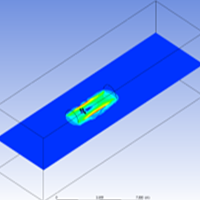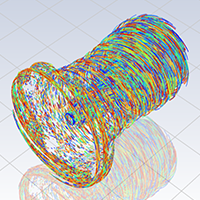Introduction to Computer-Aided Engineering (CAE)
Computer-Aided Engineering or CAE is a set of engineering techniques involving the use of simulation software to solve complex problems. It enables products to be designed, optimized, and their development digitally planned, even before a physical prototype is manufactured. Over the past two decades, the IT sector has evolved rapidly, and with it, CAE techniques based on high-performance computers. It has become indispensable, opening up undreamt-of possibilities in many fields.
→ Get It Now: Free Consultation For Your Project ←

The Different Types of CAE
Computer-Aided Engineering has revolutionized the engineering sector offering many possibilities. It has completely changed the way engineers and companies design, test and manufacture their products. At every stage of a product’s development, this modern engineering ensures that processes are optimized. Let’s Discover the different techniques used in CAE and how each of them brings added value to development processes.
1. Computer-Aided Design (CAD)
If there were to be just one technique in Computer-Aided Engineering, it would certainly be the Computer-Aided Design. The main advance in this engineering field is the possibility to reproduce a product or any physical phenomenon, numerically. Whether in two dimensions (2D) or three dimensions (3D), CAD enables engineers to design and create extremely precise and detailed digital models. These range from commonplace consumer products to industrial machine parts.
This new technology is realized using high-performance computers and appropriate software, such as SolidWorks and AutoCAD. It offers experts a multitude of functions for digitally visualizing projects, designing products, reducing risks of human errors, and improving precision. By using these techniques, companies can accelerate their development cycle while reducing costs.

Should you require further guidance on whether or not to opt for a CAE technique for your mechanical engineering project, we invite you to schedule a no-obligation, free consultation with our experts. The decision-making process will probably be more straightforward.
2. Finite Element Analysis (FEA)
Finite Element Analysis is a technique commonly used by engineers in modern engineering. It is based on the Finite Element Method (FEM), which enables complex problems (equations) to be solved by transforming them into a series of simpler problems.
Thanks to this method, it becomes possible to numerically simulate any natural phenomenon using computers.
This is achieved by software (SolidWorks, ANSYS) that reproduces all or part of a system, to study its behavior when subjected to particular conditions. This ranges from the structure of a building or bridge, whose weak points need to be determined, to the study of heat distribution within industrial equipment.
Overall, Finite Element Analysis enables engineering experts to reproduce and study the effects of external factors on a given product. It helps to improve product performance while reducing the number of prototypes to be produced.
3. Computational Fluid Dynamics (CFD)



Computational Fluid Dynamics is a branch of fluid mechanics. It uses mathematical equations to analyze the motion of fluids (liquid or gas) and their interactions with elements inside their environment. Although CFD and FEM are two distinct methods, they could be complementary.
CFD is a set of computerized processes designed to numerically reproduce the behavior of fluids. It is performed by engineers using specialized CFD software such as SolidWorks, ANSYS, SimScale, AutoDesk, etc.
These tools serve to create 3D models in order to simulate real-life conditions. This might involve analyzing airflow around a high-speed car, the movement of water inside a duct, or the transfer of heat inside any industrial equipment.
4. Multi-Body Dynamics (MBD)
The fourth method used is Multibody System Dynamics. Each of the methods mentioned above includes either an isolated solid body or a solid body in contact with a fluid. The latter MBD method enables engineers to simulate movements and interactions within a system composed of several solid bodies. These may be rigid or flexible bodies interacting with each other, or with a fluid in their immediate environment.
These different bodies may be connected by elements such as :
- Joints
- Bearings
- Gears
- Springs
- Dampers, etc.
They are modeled, and their interactions are identified. Depending on the situation, this could be contact, friction, inertia, etc., which globally define the movements within the system. Not only must internal interactions be considered, but also the effects of external forces such as gravity, input forces (a motor), or electromagnetic forces, etc.
Generally speaking, the more you take into account the factors acting on the system, the more reliable your simulation results will be.
5. Thermal Analysis
Thermal analysis enables us to understand and predict the behavior of an object or product when subjected to a change in temperature. Under thermal stress, the components of a system may overheat, and/or change volume due to expansion or contraction.
Industrial equipment, aircraft, and cars, for example, are made up of many thousands of parts working in harmony with one another. The heat generated when running can potentially create instability, since it may induce a change in the properties of each component.
The purpose of Thermal Analysis is to prevent any future malfunction of a product when subjected to such extreme conditions. To achieve this, engineers carry out tests on the models produced to ensure their resistance.
With this technique, experts study the product using adapted software, which offers a reliable numerical simulation.
The study of heat transfer in a body is commonly used. It highlights the movement of heat due to a temperature gradient. Three methods are used, conduction, convection, and radiation (heat transfer):
- Conduction induces heat movement within a solid object
- Convection is responsible for the loss or gain of heat by a solid object. This implies that the object is in contact with a fluid such as water, air, or any other liquid or gas
- Radiation, on the other hand, is responsible for heat loss or gain without the object in question being surrounded by any fluid.
Advantages of Computer-Aided Engineering



CAE techniques have rapidly evolved in recent years. On the one hand, this is mainly due to the continuous development of high-performance computers capable of solving complex equations. On the other hand, the versatility of the Computer-Aided Engineering principle means that it could be adapted to most of the fields.
From innovation-driven sectors like automotive and aeronautics, or energy to biomedical applications, their advantages are numerous. Here’s a non-exhaustive list:
- Reducing product development time and costs
- Greater Propensity to innovate (Research and Development)
- Higher product efficiency
- Reducing environmental impact, etc.
1. Reducing Product Development Time and Costs
When it comes to products or components that will be used for technical purposes, they need to strike the right balance between compliance with norms & standards on the one hand, and ergonomics on the other. In concrete terms, this translates into a lengthy development period, with multiple testing phases.
Each phase necessitates the fabrication of one or more tangible prototypes, accompanied by concomitant financial constraints. Fortunately, this was before the advent of Computer-Aided Engineering. Thanks to the development of new processes, modern engineering is able to simulate the majority of test phases using appropriate software. On the one hand, this means that the number of physical prototypes can be reduced to a minimum, while on the other, optimal products can be designed.
Then, the financial constraints that previously precluded the participation of a greater number of companies in the product development process, are now alleviated.
→ Find how Computer-Aided Engineering can Support your Businees ←
2. Greater Propensity to Innovate (Research and Development)
Regardless of the industry, two main factors are essential for driving innovation. Firstly, managing with a significant development time and secondly, having sufficient financial resources.
No matter how compelling, innovative ideas remain concepts until they are validated. That requires several stages of testing, including the production of early prototypes. For well-resourced companies, these phases may seem like mere formalities. For smaller companies, however, they can be an absolute hindrance. Therein lies the advantage of using Computer-Aided Engineering.
Financial constraints and development time are reduced by digitally simulating the testing phases. And this makes it easier for any company to explore innovative ideas, even with limited resources.
3. Higher Product Efficiency
In the past, engineers relied on complex mathematical calculations and manual prototyping to design and test products, dealing with all the associated risks of error.
With Computer-Aided Engineering technology, it becomes relatively fast to simulate a large number of concepts. Considering that in traditional engineering each of these concepts would have required a prototype, the question of added value no longer arises.
Errors or design flaws that were once risks being managed, are no longer. They are now as easy to fix as a bug in a computer program. So, instead of being considered as a constraint, any error identified during the simulation phase becomes a given opportunity to enhance the final product performance and minimize any future risks in the process.
In the aerospace industry, for example, the development of high-performance aircraft such as the Boeing 787 has benefited greatly from the advantages of CFD simulation.
4. Reducing Environmental Impact
This section could almost be summed up in one sentence: Computer-Aided Engineering ensures better management of available resources and the possibility of designing equipment that is more respectful of the environment.
In practice, when it comes to product development, this includes:
- Reducing in the number of prototypes to be designed, in other words, a reduction in the number of resources consumed, and waste discharged.
- Designing equipment that consumes much less energy, thanks to simulations
- Optimizing product lifespan, to avoid the need for parts replacement in the future, will increase the ecological footprint.
- A product optimized for better recycling, thanks to a well-considered choice of materials.
- Innovations in the design and development of renewable energies.
Computer-Aided engineering (CAE) techniques represent a significant advancement in engineering research. They have facilitated the investigation of hitherto unexplored possibilities. Currently, despite its relatively recent development, CAE is already employed across most product development fields. Its use is particularly notable in dynamic fields such as aeronautics and the automotive industry, as well as in sensitive areas such as renewable energies or biomedicals. As cloud-based software facilitates the democratization of this technology, it is reasonable to posit that CAE is still in its infancy.
Now that you’ve seen the value of Computer-Aided Engineering, let’s discuss your next project.
Or maybe you want to read more, then take a look at Introduction to CFD Simulation.
Helping SME Achieve Technical Innovation through CAE
Share this post, don’t forget!


